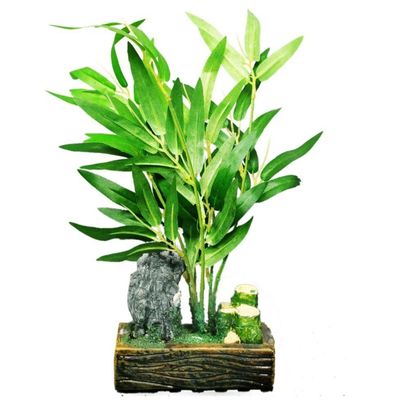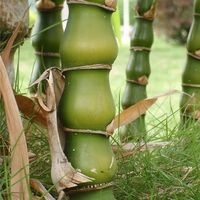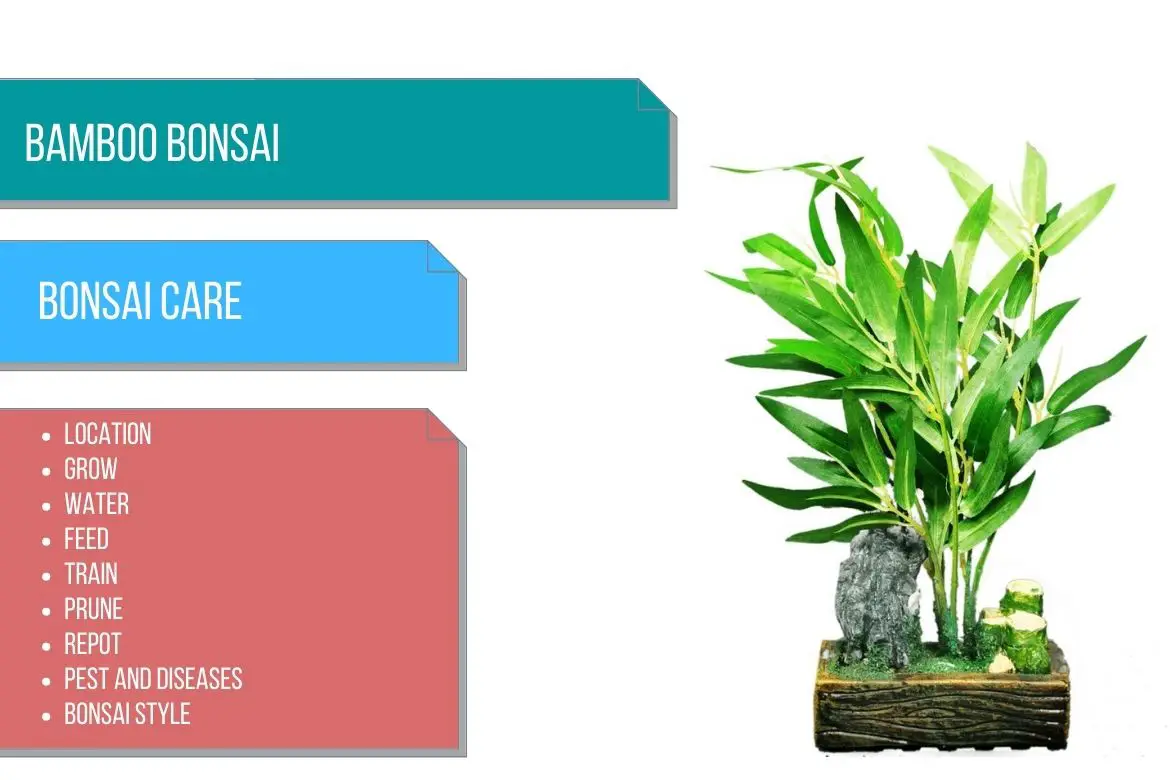
Bamboo
(Arundinaria)
Country of Origin : Japan, China ad north America
Bonsai Styles : Informal upright, clump, twin trunk, group, landscape
Zone : 7 – 10
It is probably the species with the most oriental flavor, yet it is rarely used as a bonsai specimen in the East. The exception is group plantings on flat slabs that mimic the appearance of natural groves. Arundinaria is a bamboo species which is native to North America.
As their grass-like leaves tremble in the slightest breeze, bamboo canes add an oriental feel to any garden.
A bamboo is usually used as an accent planting when displaying bonsai of other species as part of a tokanoma, a traditional Japanese display.
Bamboos, however, are generally considered bonsai in their own right in the West, largely due to their curiosity value.
Some of the common bamboo varieties used to make bamboo bonsai are :
- Phyllostachys aurea – It is also known as ‘Golden bamboo‘. This is a dwarf variety of bamboo. As a compact bamboo subspecies, it can easily fit in a small pot and has a stunning appearance.
- Nandina domestica – It is also known as ‘sacred bamboo‘ and ‘heavenly bamboo‘. It is a evergreen or semi-evergreen small shrub. The style and size of its bonsai is comparable to that of the Arundinaria. It is known fro its red berries and attractive foliage color.
- Pseudosasa owatarii – This bamboo is a cold-hardy running bamboo from Japan that only grows to a height of about 1 foot and has rich green foliage. Due to its small size, this variety can be easily kept in a small bonsai pot.
- Pleioblastus pygmaeus – Another popular dwarf bamboo species, Pygmy bamboo has solid, bright green leaves with small hair. The plant usually grows up to about 2 feet high, but it can be pruned much shorter, which makes it ideal for bonsai.
- Bambusa ventricosa – It is also known as ‘Buddha bamboo‘ and ‘Buddha’s-belly bamboo‘. This bonsai species can grow quite high. However, it can be potted in a bonsai pot and miniaturized. Under the stress of being planted in a pot, the bonsai plant will start having its internodes bulging out, looking like a belly, hence the name Buddhas belly. Water-stressed plants will have their clums growing in a very interesting zig-zag pattern.
Buddha bamboo‘ or ‘Buddha’s-belly bamboo‘. Bambusa ventricosa bamboo.

Best location keep Bamboo Bonsai
You should place the bonsai near a sunny window, but where it will be shaded from direct sunlight during the hottest part of the day.
Outside, bamboo can receive whatever amount of sun you wish, as long as the soil does not dry out.
It can tolerate high temperatures as long as humidity is maintained. Do not expose the bamboo bonsai plant to temperatures below 40°F (4°C).
Bamboo bonsai can grow with pretty much no issues in a temperature range of 40-100°F (4-37°C).
While bamboo is generally hardy when grown in the ground, it is not as hardy when grown in bonsai containers. Hence protect a potted bamboo from cold.
It is ideal for bamboo to spend their summers outside, but they can stay indoors all year if they are provided with enough sunlight and fresh air. The air should not be too dry.
Propagation of Bamboo
Bamboo can be propagated via rhizomes.
Divide the rhizomes and plant them in early spring.
Watering Bamboo Bonsai
As long as the soil is moist, bamboo thrives, but suffers from root rot if it is waterlogged.
At the very least, water bamboo bonsai every day, more often if they are grown on slabs or in shallow pots.
When the weather is hot, water frequently. In the winter, decrease the amount of water, but do not let the bonsai soil become dry.
To reduce the frequency of watering you can use a deeper bonsai container. However, generally it doesn’t go well with the aesthetics of the bamboo bonsai style.
Wiring Bamboo Bonsai
You can wire young branches, emerging from the main trunk, of bamboo plant.
Wiring can be done with copper or aluminum wire.
Pruning Bamboo Bonsai
When to prune bamboo bonsai?
With a sharp knife, cut out overgrown or dominant stems just below the soil level early spring to late summer. You can remove unwanted new shoots when they are still young and soft.
Cut dwarf forms straight down to the ground in early spring. It is possible to control larger bonsai varieties by systematic peeling of leaf sheaths, however this is not essential.
Pinching Bamboo Bonsai
Tweeze out the growing tip of each stem after it reaches the desired height.
Maintain a bamboo-like appearance by thinning out side growth.
Repotting Bamboo Bonsai
When to repot Bamboo bonsai?
Repot bamboo bonsai every two to three years in spring or fall.
Take the ‘wedges’ out of the dense root system and dispose of them or plant elsewhere. You can reorganize the remaining root sections in the pot to improve the design.
Stack the thickest stems at the center and the smallest ones at the rear and sides to create the illusion of perspective.
When planting on a slab or rock, ensure there are no depressions in the surface which might trap water.
Combine the standard bonsai soil mix with a couple of extra handfuls of organic matter, when planting in a shallow bonsai pot or slab.
Ensure that the bonsai soil is free draining in case you are going to use deep bonsai container.
Feeding Bamboo Bonsai
Apply a balanced fertilizer to the bamboo bonsai during spring and summer. Bonsai plants that have not been overwintered indoors will be toughened by nitrogen-free fertilizer. You can also use a weak balanced feed in winter to bamboo bonsai growin in warm house.
OR
In the growing season, half-strength balanced fertilizer can be used with a low-nitrogen top-up in the fall.
Diseases and pest of Bamboo Bonsai
Stems can be colonized by scale insects quickly
Clusters of small shoots at internodes are occasionally infested by spider mites.
Waterlogged bonsai plants are prone to root rot.
Bamboo bonsai care
Waterlogged soil is as dangerous to the bamboo bonsai as bone dry soil. In both the cases the plant will die.
You probably have either congested roots or a stem that is too large draining energy from the others if your bonsai grove begins to deteriorate.
In case the roots are congested, repot the bonsai tree on a bigger temporary container till the next potting season.
Or, you can also divide the plants and plant them in another container. Pruning the roots is also a good idea.
Cut the oversized stems at the base. This will rejuvenate the main clum on the bonsai.
What to look for when buying Bamboo Bonsai
Select a bamboo variety whose leaves are small, neat, and uniform in size.
Over time, bamboo roots become congested and more prone to waterlogging if they are kept in the same soil. As a result, the base of the stems rot.
Examine each stem’s base carefully.

